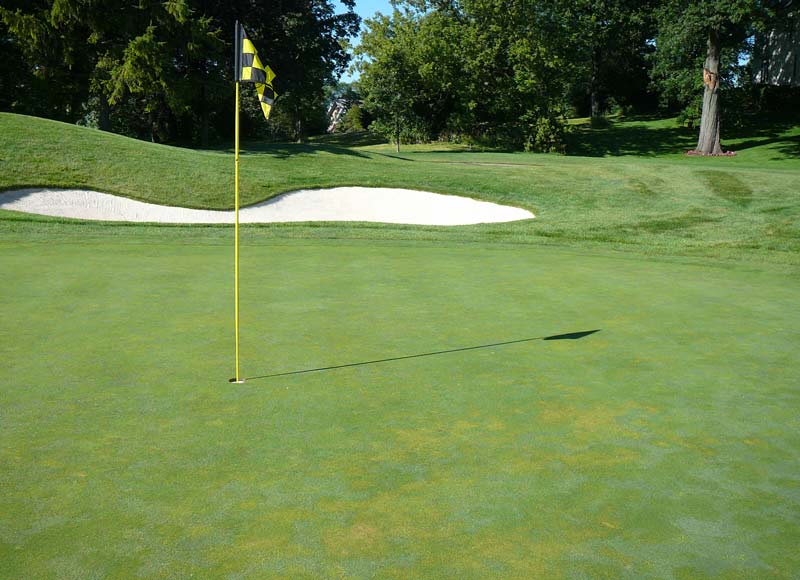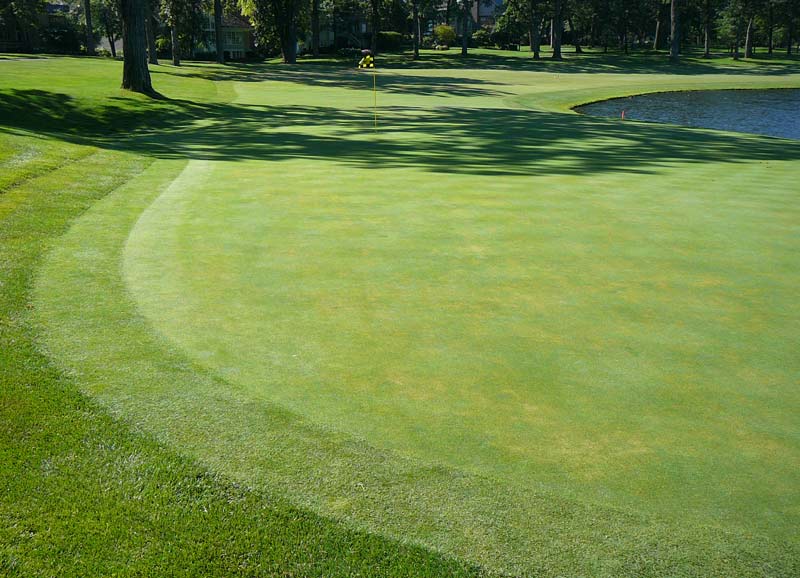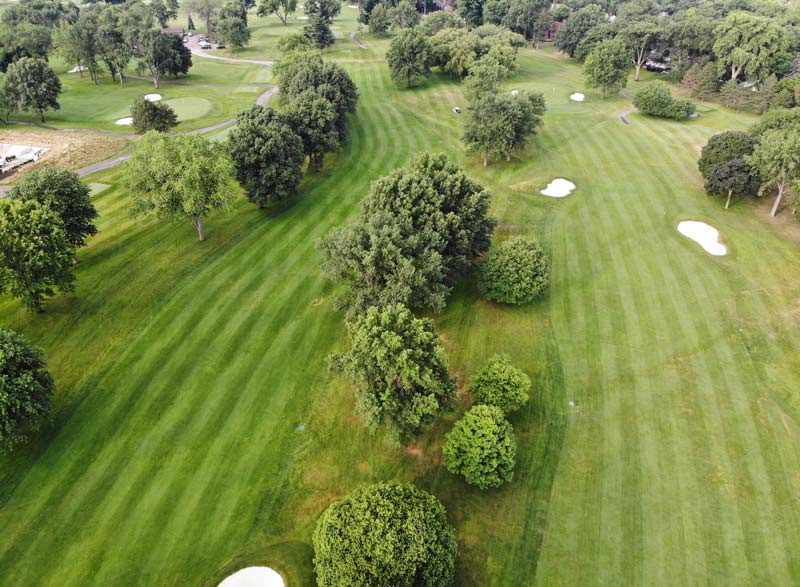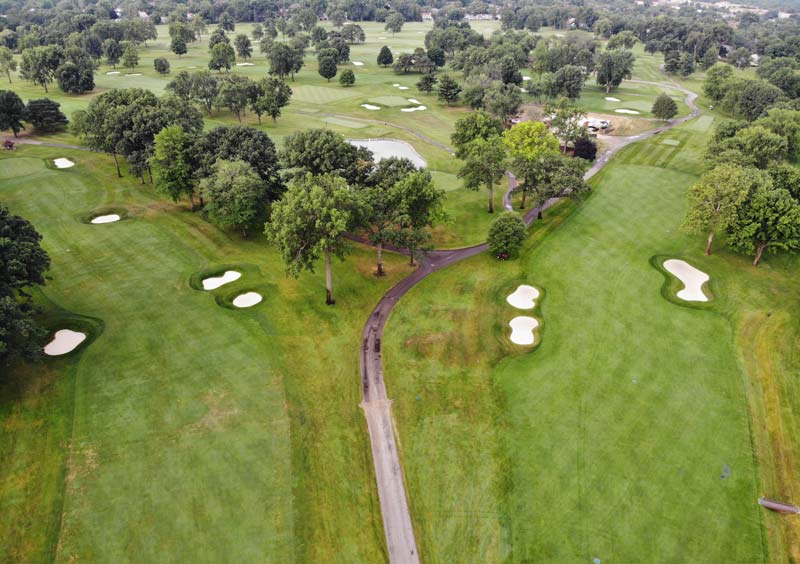
An annual bluegrass green yellows under the strains of summer. Photos courtesy of Bayer
Editor’s note: The following article was supplied by Bayer. All product claims, research cited and other information is directly from the company.
When summer stress creeps up on bentgrass and bluegrass greens, comprehensive cultural management techniques and a well-coordinated fungicide program can help maximize fungicide activity and overall turf performance. Stressed-out turf doesn’t have to be “normal” — handling it just requires getting a solid program in place.
Understanding turf stress and summer decline
Because of the complexity of summer decline, specific causes are not well understood. Pathogens such as Colletotrichum cereale (anthracnose), Rhizoctonia spp. and Pythium spp. can play a role in summer decline by attacking stressed turf. Previous research by Bingru Huang, Ph.D., at Rutgers University found that heat stress is a primary factor contributing to weakened turf during the summer (Golf Course Management 69(7):61-64).
Turf stress falls into two main categories:
• Biotic stresses: These are stresses caused by living organisms such as diseases, insects and nematodes.
• Abiotic stresses: These account for all nonliving factors that affect turf health, such as high daytime or nighttime temperatures, high relative humidity, excess soil moisture, poor air movement, traffic wear, and drought.
It’s important to remember that these stresses can compound over time. A common misconception about summer turf stress is that the stressed-out turf is a result of recent conditions, when in reality, actions or environmental conditions from the previous spring and winter can now be coming into effect. Unfortunately, discerning whether decline is from recent stress, historical stress or a combination of the two is usually very difficult.
Monitoring and documenting turf decline throughout the seasons can help pinpoint problematic areas on the golf course that are prone to stress. With technology such as drones, infrared thermal imaging, normalized difference vegetation index (NDVI), time-domain reflectometry/volumetric water content and others, turf managers can now, more than ever before, detect and act upon abiotic stresses that may not otherwise be visible to the naked eye.
As the list above shows, numerous factors contribute to turf stress. The key for golf course superintendents is to put in place a strong agronomic program that helps ensure turf is in its best possible health prior to a period of stress. Consider the following tips for monitoring turf stress periods and building toward a strong cultural and chemical agronomic program.
Tracking air and soil temperatures
Air and soil temperatures are a great indicator of when shoot growth and root growth are occurring. Optimum shoot growth for cool-season grasses occurs at 60 to 75 degrees F. Optimum root growth occurs when soil temperatures are at 50 to 65 degrees F. Shoot growth and root growth cease when air temperatures reach above 90 degrees F and soil temperatures above 77 degrees F, respectively.
These temperatures are often exceeded on creeping bentgrass and annual bluegrass putting greens during the summer. The high temperatures cause roots of cool-season grasses to decline and also inhibit the growth of new roots. The declining roots are more susceptible to root-rotting fungi and other stresses, while the new roots do not grow to replace the old roots.

Thinning turf is visible on this walk-off area, which gets extra traffic.
As detrimental temperatures are reached or surpassed, summer decline symptoms can include poor turfgrass vigor, chlorotic turf, reduced density, a diminished root system, disease activity and overall inferior turf quality. Preventive and proactive cultural and chemical strategies are important for preparing turf stands for these peak stress periods, so superintendents must start thinking about managing summer stress before the symptoms are recognizable.
Long-term cultural management techniques for summer turf stress
Proper cultural practices are critical to preventing and alleviating summertime turf stress. These include:
• Maximizing photosynthesis whenever possible. Mow and roll on alternate days to help relieve turf stress. Raise the height of cut when possible, and supplement with rolling to maintain green speed.
• Venting throughout summer with needle tines or similar.
• Incorporating light, frequent topdressing.
• Syringing to briefly lower canopy temperature and provide targeted moisture without overwatering.
• Limiting grooming or vertical mowing during periods of elevated air temperatures.
• Improving air movement by removing trees or using fans around greens.
• Spoon-feeding with water-soluble nutrients.
• Switching to smooth vs. grooved rollers.
• Using growth regulators judiciously to maintain putting green speed while not over-regulating and excessively limiting growth.
A focus on prevention
Mother Nature can be brutal throughout the summer, and a well-structured preventative fungicide program can make a significant difference in your turf’s performance in the face of it. Fungicide applications should be initiated in late spring/early summer prior to the onset of summer stress and continued throughout the summer months.
When selecting a product for summer applications, remember that controlling disease is table stakes. For optimal performance, consider solutions that provide benefits beyond disease control.
The Bayer Stressgard portfolio, for example, offers the following benefits:
- Enhanced photosynthesis
- Increased summer turf safety
- Better performance under shade
- Improved spring green-up and early-season turf health
- Improved tolerance of drought and heat stress
- Improved turf quality under traffic (golfer and mechanical)
- Reduced oxidative stress
- Enhanced turf color, both immediately and long term
- Labeled plant health effects that go beyond disease control

Stressgard program (left) vs. a normal fungicide program (right).

A normal fungicide program (left) vs. Stressgard program (right).
Versatility is another notable benefit. Unlike other turf health products on the market, Stressgard isn’t dependent on a single active ingredient to deliver results. For more information about mitigating summer turf stress and other key turf issues, reference the Bayer Golf Solutions Guide.
Rob Golembiewski, Ph.D., and Paul Giordano, Ph.D., are Bayer Green Solutions Team specialists. They have more than 26 years and more than 15 years of experience in the turfgrass industry, respectively.